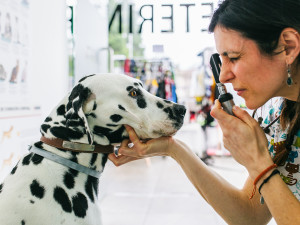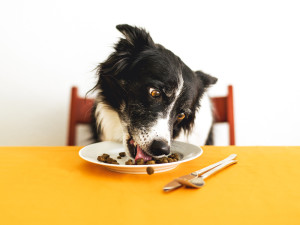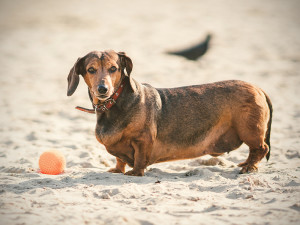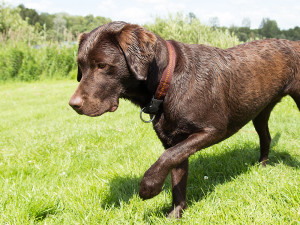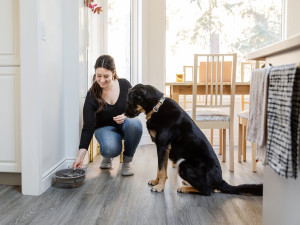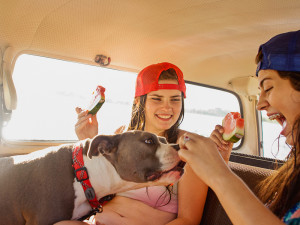Should You Put Your Dog on a Low-Calorie Diet?
Diet culture is a tricky thing — for pets, too.

share article

Your pet wants you to read our newsletter. (Then give them a treat.)
OK, so you love your pup — no matter what size they are. You might even think a little extra fluff looks pretty damn cute (there’s truly no denying it). But there’s also no denying canine obesityopens in a new tab is a major health issue. Obesity contributes to arthritisopens in a new tab, heart and liver disease, diabetesopens in a new tab, respiratory difficulties, heat strokeopens in a new tab, some cancersopens in a new tab, and more. And somewhere between 40 and 50 percent of domestic cats and dogs in the U.S, are overweight, according to several estimates. When trying to help our pups slim down, humans often turn to reduced calorie diets. Unfortunately, these may not be the straightforward solution they appear to be.
A study of so-called light or low-calorie pet foods performed at the Cummings School of Veterinary Medicine at Tufts University revealed a confusing variation in calorie density — that’s the calories per cup — and feeding recommendations among brands.
Researchers found “low-calorie” dry dog foods making weight management claims had a huge range of recommendations. They ranged in calorie density from 217 to 440 kilocalories per cup, and the recommended intake ranged from 0.73 to 1.47 times the dog’s resting-energy requirement.
Not Really “Low-Calorie” Diets
Well-meaning dog owners following manufacturer guidelines might not see promised weight loss in their chubby pups — in fact, they might see weight gain — leading to frustration for people and ill health for dogs.
Knowing and counting calories is a priority for weight management, according to board certified veterinary nutritionist Dr. Edward Moser, who spoke about the Tufts study and canine weight management.
“It’s incumbent on the pet owner to know what calories are in the food and the energy their dog needs,” Dr. Moser says. While weight and age are good starting points for calculating what your dog requires to maintain or lose weight, there are other important factors to take into consideration, such as whether the dog is spayed or neuteredopens in a new tab, and the intensity and duration of their daily activity. Also, pregnant or nursing dogs and puppies need more energy (a.k.a. calories).
A good way to set a calorie baseline is with a visit to your veterinarian. There are several ways to set a daily calorie count, such as aiming for a one percent of total weight loss each week, or 75 percent of the calories required to maintain a goal weight, etc., Dr. Moser says.
The important thing is to be consistent and engaged. Once you cut back on calories, weigh your dog about every 10 days, Dr. Moser says, to see when they plateau. Also, he recommends something called “body condition scoring.” The Ohio State University College of Veterinary Medicine website provides an illustrated chartopens in a new tab that shows what cats and dogs look like when they are underweight vs. obese. Look at the pictures and ask: Where does my dog fit? You should be able to feel your dog’s ribs, but your fingers shouldn’t fit between them.
Helping Your Dog Lose Weight
Why diet food? Why not just feed your dog less of their regular food? “What makes a diet food different is we’re essentially diluting calories,” Dr. Moser says. There are only a couple ways you can do that, including reducing fat content, which decreases calorie density and palatability, or adding fiber or even air, in the case of kibble. The calories in canned food can be diluted with water. “We are making dogs think they are full when they’ve really only eaten 75 percent of the calories,” Dr. Moser says. “The other stuff is just helping you feed more so the dog doesn’t beg.”
One reason Dr. Moser says people aren’t successful with low-calorie food is because they leave it out for free-choice feeding. (Imagine a sort of bottomless bowl.) “Because even low-calorie foods have calories,” he says. He agrees with the study recommendation that free-choice feeding is not a good option — in part because food today is extremely palatable, so it’s easy for dogs to overeat. The better option is a measured quantity of food a couple of times a day, he says.
If you don’t see calories listed on your label, that’s because calorie counts are only required on dog food that claims to be lite, light, less calorie, or low calorie. (The Academy of Canine Veterinary Nutrition, to which study co-author Dr. Lisa Freeman and Dr. Moser belong, advocates for requiring calorie information on all pet food labels.) Foods with a light, lite, or low-calorie designation must also adhere to a maximum kilocalorie per kilogram restriction. However, Dr. Freeman pointed out that more than half of the foods evaluated in her study exceeded this maximum.
Why does it matter if your pup’s a little plump? Dr. Moser points to research that shows keeping dogs thin can extend their lives by as much as 18 months — that’s enough to motivate us to study labels and get out our measuring cups.
Disclaimer alert: This article is here to share information. But, much like pineapple on pizza, the topic may be controversial. Meaning, not all vets or pet professionals agree. Because every pet is a unique weirdo with specific needs. So, don’t take this as fact or medical advice. Talk things over with your vet when making decisions, and use your best judgment (about both your pet’s health and pizza toppings).

Lisa Wogan
Lisa Wogan lives in Seattle and is the author of several books including Dog Park Wisdom.
Related articles
![Cheerful Brunette Having Fun With Her Dog Outside]() opens in a new tab
opens in a new tabBig Fish: The Best Omega-3 Supplements for Dogs (And Why They Need Them)
Fatty acids rev up your dog’s energy, keep their coat shiny, help with inflammation from allergies and arthritis, and so much more.
![Young female veterinarian in her consulting room performing a medical examination on a dog for diabetes]() opens in a new tab
opens in a new tabDiabetes in Dogs: Symptoms, Treatment, and Prevention
Learn which breeds are at risk, the symptoms to look out for, and what treatment options are available.
![An obese dachshund dog plays with a rubber ball on a sandy beach]() opens in a new tab
opens in a new tabWhat to Know When Your Vet Says Your Dog Is Overweight
Don’t take it personally — even if that’s hard to do.
![Brown Labrador lifting front leg]() opens in a new tab
opens in a new tabHow to Get a Head Start on Your Pet’s Health
Spot lumps, limps, and lethargy early on.
![Young Female Adult Feeds Her Rottweiler mixed breed Dog]() opens in a new tab
opens in a new tabWholesome Homemade Dog Food Recipes: Vet-Approved Starter Recipe
All it takes is healthy ingredients and a slow cooker.
![Teenagers Feeding a Dog Watermelon While Sitting In Car On a Sunny Day]() opens in a new tab
opens in a new tab9 Healthy Summer Snacks to Share With Your Dog
Your pup wants in on your crudité platter.
